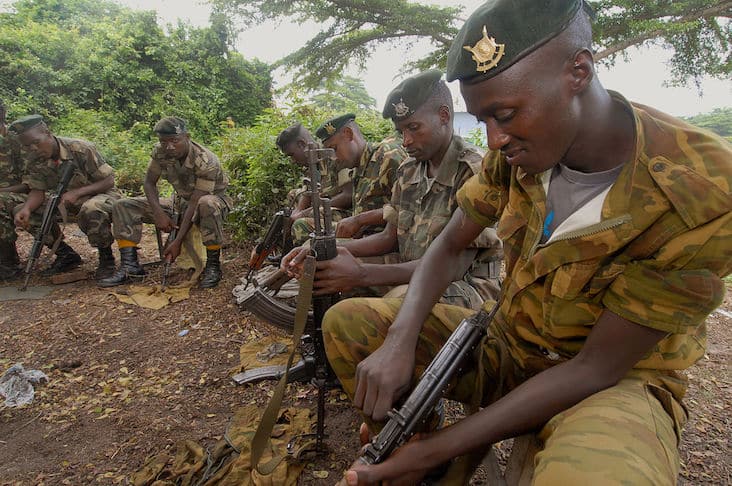The most interesting facts about Burundi, from a man-eating crocodile called Gustave to a tragic history of genocide and war.

Fast facts
Official name: Republic of Burundi
Capital city: Bujumbura / Gitega
Population: 11,865,821
Area: 27,830 sq km
Major languages: Kirundi, French, Swahili, English
Time zone: UTC+2 (Central Africa Time)
– Source: CIA World Fact Book
Interesting facts about Burundi
1. Burundi is a landlocked country in Africa. Landlocked countries are entirely encompassed by land with no access to the sea. There are currently 45 landlocked countries as well as five partially recognised states.
– Source: CIA World Fact Book, The Telegraph
2. Burundi was initially inhabited by the Twa – a Pygmy hunter-gatherer people.
– Source: Britannica

3. Hutu people settle in the region, followed by Tutsi settlers who arrived in the 1400s. During the 1500s a defined Burundian kingdom emerged known as Urundi.
– Source: BBC News
4. Unlike many sub-Saharan African countries, the borders of Burundi were not created by European powers. Instead, they were conceived by the original Burundian monarchy.
– Source: Britannica
5. The Burundi flag is red, which represents the struggle for independence, and green, which represents the hope for future development. There are a white diagonal cross and a central white disk which symbolise peace.
– Source: Britannica

6. The central three stars represent the three main ethnic groups of Burundi – the Tutsi, Hutu and Twa – as well as the national motto, “Unity, work, progress.”
– Source: Britannica
7. In 1890, the kingdoms of Urundi (Burundi) and neighbouring Ruanda (Rwanda) were colonised by Germany and incorporated into German East Africa.
– Source: BBC News
8. Belgium then occupied Burundi until 1962, when the country finally seceded and became the independent Kingdom of Burundi.
– Source: BBC News
9. Since independence, Burundi has been plagued by tension between the usually-dominant Tutsi minority and the Hutu majority.
– Source: BBC News

10. Burundi has seen two mass genocides. In 1972, government troops massacred more than 100,000 Hutus. Then in 1993, the assassination of the president led to an ethnic conflict which claimed more than 300,000 lives.
– Source: The Guardian
11. The following 12-year ethnic-based civil war lasted from 1993 until 2005.
– Source: The Guardian
12. Lake Tanganyika is the world’s longest freshwater lake, the second-deepest and the second-largest in volume. It is also the second-largest of the African Great Lakes after Lake Victoria.
– Source: Britannica, National Geographic, New World Encyclopedia
13. Burundi is one of the world’s worst countries for internet access. Just 3% of the population has access to the internet.
– Source: World Bank

14. Burundi officially has two capital cities. In 2019, parliament decided to make Gitega the political capital of the country while Bujumbura would remain its economic capital.
– Source: CIA World Fact Book
15. Burundi won its first Olympic gold medal in its debut appearance at the 1996 Olympic Games. Vénuste Niyongabo won gold in the men’s 5,000m. Until 1993, Burundi was not even a member of the International Olympic Committee
– Source: New York Times, International Olympic Committee
16. Burundi is home to Gustave, a man-eating crocodile responsible for killing hundreds of people. The crocodile lives in Lake Tanganyika and is thought to be over 60 years old and has attacked hundreds of people between 1987 and 2009. It is unknown if he is still alive.
– Source: National Geographic

17. Cows are a symbol of happiness, health and prosperity in Burundi. A common Kirundi greeting is “amashyo,” which translates as “may you have many herds of cattle.” The response is “amashongore” which translates as “may you have many herds of female cattle.”
– Source: Aimable Twagilimana (2015) Historical Dictionary of Rwanda. Rowman & Littlefield: London
18. Continued unrest in Burundi has seen the rise of kwashiorkor or severe acute malnutrition (SAM).
– Source: The Guardian
19. In 2014, Burundi, was ranked as the world’s hungriest – or most undernourished – country in the Global Hunger Index for the third year in a row.
– Source: Reuters
20. As such, Burundi is also one of the world’s least obese countries. A 2017 study ranked Burundi as the world’s 10th least obese nation – and Africa’s fourth.
– Source: World Health Organisation
21. Burundi is the poorest country in the world when measured by GDP per capita based on purchasing power parity (PPP).
– Source: World Bank

22. Outside Bujumbura is the Livingstone–Stanley Monument, marking the spot where explorers Dr David Livingstone and Henry Morton Stanley visited and spent two nights in 1871. However, it is not the infamous “Dr Livingstone, I presume?” meeting that took place in Tanzania.
– Source: Lonely Planet, Smithsonian
23. In 2014, jogging was made a crime in Burundi. President Pierre Nkurunziza had decreed that jogging could be used as a cover for subversion (planning anti-government rebellion).
– Source: BBC News
24. East Africans, particularly Burundians, are known for brewing banana beer. The beer is often drunk in groups from a single large container and through straws.
– Source: Africanews (video)
Every effort has been made to verify these facts about Burundi. However, if you find an error or have any questions, please contact us.